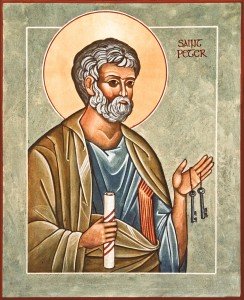In a chronologically ordered New Testament (NT), the letter that must be considered after second Thessalonians, is First Peter. I suspect that most people have never read or heard First Peter proclaimed. It consists of only five, relatively short chapters.
Two letters in the NT are attributed to Peter, who was, perhaps, the most important of Jesus’ disciples since he was chosen to lead the followers of Jesus. He was executed in Rome around the year 64 C.E.
Most biblical scholars do not think that either letter was written by Peter. The letters reflect a later
historical context. Further, scholars believe that the two letters didn’t have the same author. Second Peter seems to be written significantly later than first Peter.
First Peter was most likely written from Rome. Rome is suggested in its closing, which contains greetings from those “in Babylon”. As in Revelation, “Babylon” had become a name among both Jews and Christians for Rome after Rome destroyed Jerusalem and the temple in the year 70. Babylon was the previous destroyer of Jerusalem and the temple in 586 BCE. Rome was the new “Babylon.”
But there is no unanimity about its date. Some mainline scholars date it to around 90 or as early as the 80s. The reason is that some think that the author of 1 Clement, an early Christian letter not in the NT but dated by some to around the year 96, wrote 1 Peter. If so, 95 or so is the latest possible date for 1 Peter. But it is not clear that 1 Clement was written that early. Moreover, because both 1 Clement and 1 Peter were most likely written in Rome, their authors might well have known each other. Given that, similarity of language need not mean literary dependence. Some of its themes, especially its endorsement of Roman authority and imperial conventions about slavery, suggest a date early in the second century.
The author identifies himself as “Peter, an apostle of Jesus Christ.” Recall that most scholars do not think that Peter the disciple wrote the letter. Later, the author refers to himself as an elder among elders, which implies that he was a leader in a Christ-community in Rome.
This letter uses the term scattered strangers. There is abundant evidence that this refers to Gentile Christian communities. They are envisioned as the new people of God, aliens in the pagan world. It seems that the names included indicate that the letter was meant for communities in Asia Minor

